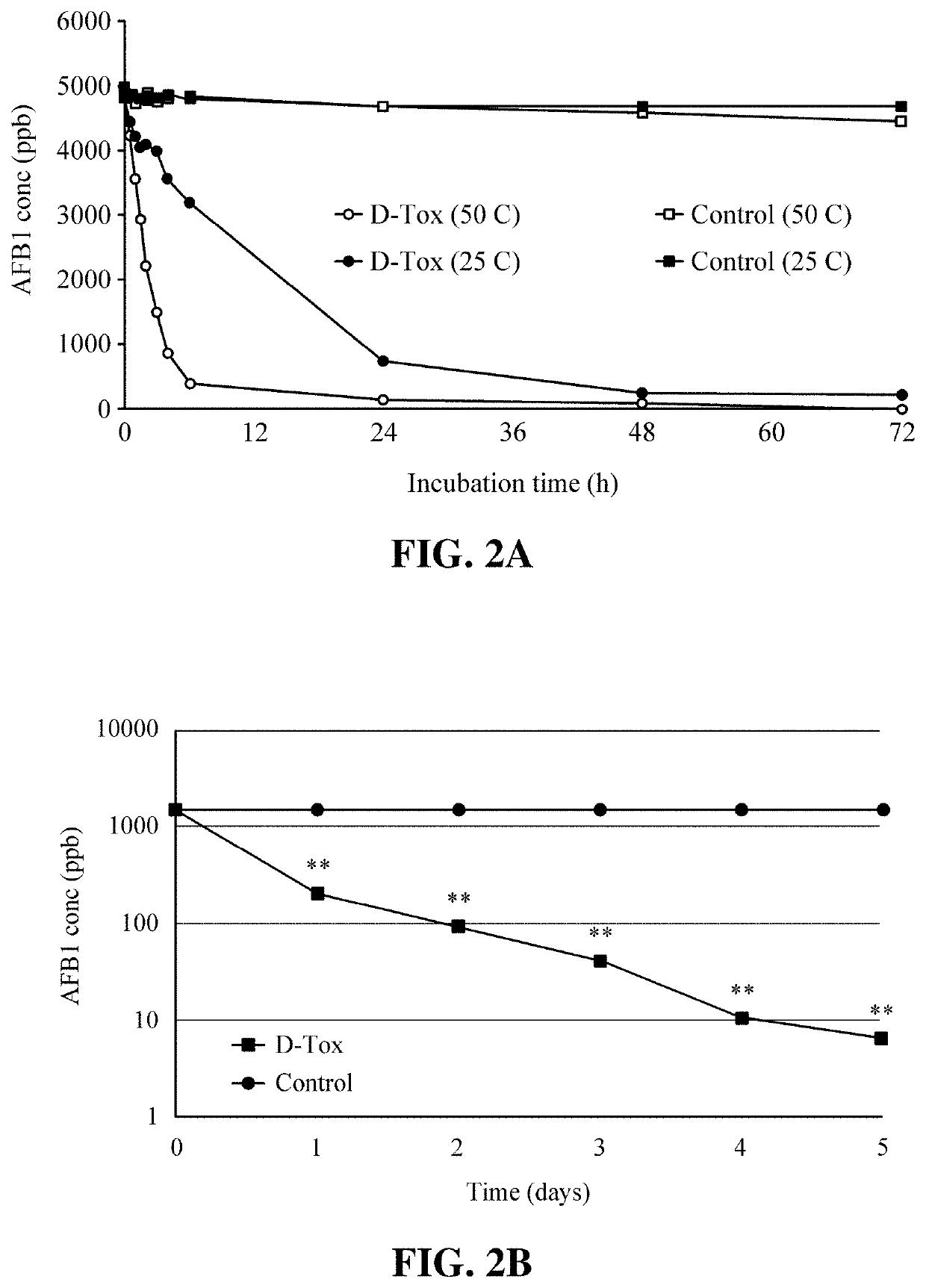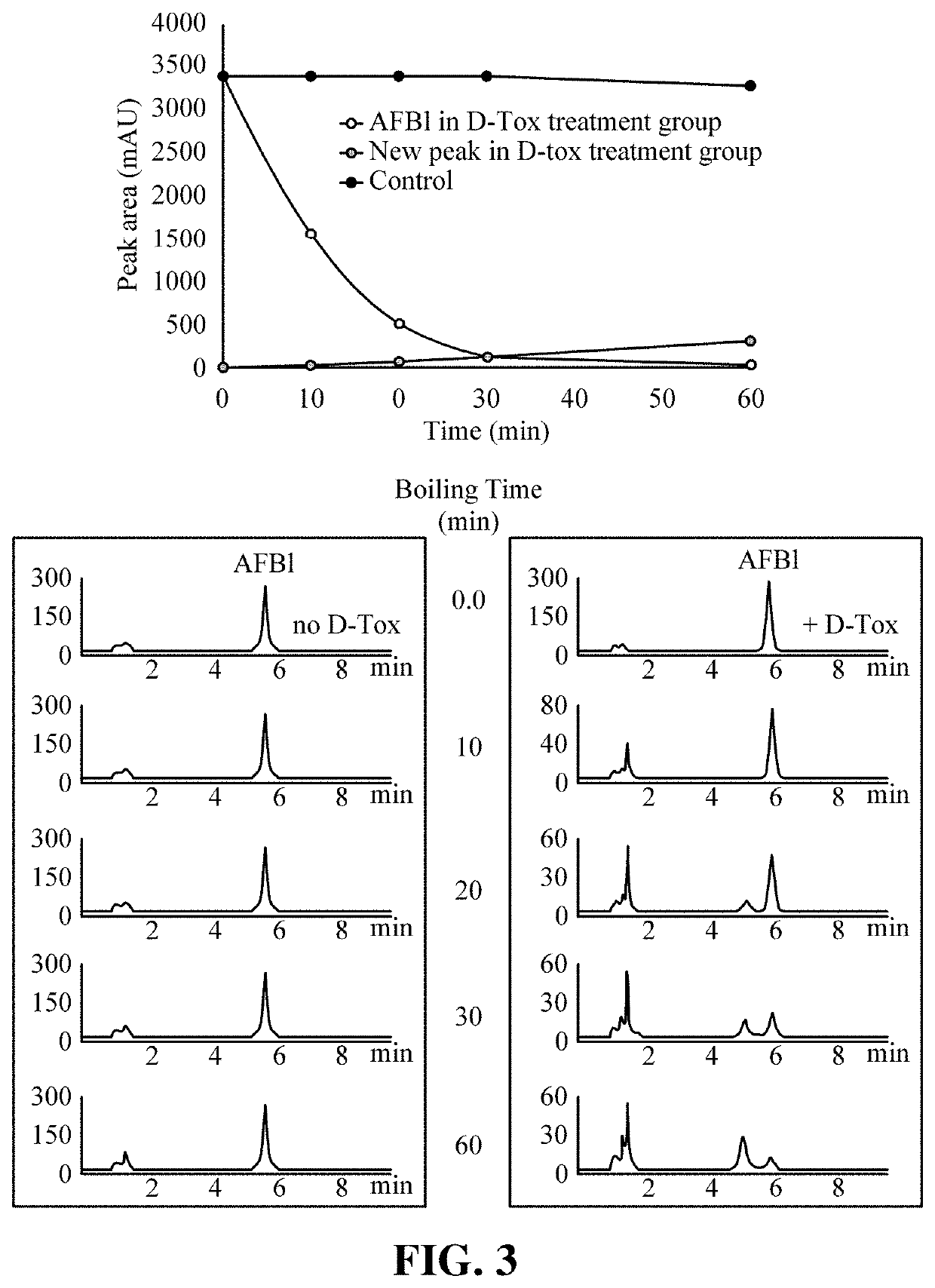Composition for degradation of mycotoxin comprising aspergillus culture filtrate as effective component and uses thereof
a technology of aspergillus and culture filtrate, which is applied in the field of composition for degradation of mycotoxin comprising aspergillus culture filtrate as an effective component, can solve the problems of difficult removal of toxins and disturbance of reproduction-related hormones, and achieve the effect of maintaining the activity of degrading mycotoxin and high efficiency
- Summary
- Abstract
- Description
- Claims
- Application Information
AI Technical Summary
Benefits of technology
Problems solved by technology
Method used
Image
Examples
example 1
of Aflatoxin-Degrading Activity of D-Tox Depending on Various Reaction Temperature and Time Conditions
[0065]The inventors analyzed the degradation level of AFB1 when AFB1 (5,000 ppb) was reacted with D-Tox A (prepared by using Aspergillus oryzae NRRL3483) for 72 hours at 25° C. or 50° C. In addition, the prolonged activity was evaluated when AFB1 (1,500 ppb) was reacted with D-Tox A for 5 days at 30° C. As a result, it was found that the AFB1-degrading activity of D-Tox A is directly correlated with the reaction temperature and time (FIGS. 2a and 2b). It was observed that more than 90% of AFB1 was degraded after 24 hours at the reaction temperature of 50° C., and, it was also found that, at the reaction temperature of 25° C., 89% of AFB1 was degraded after 48 hours. Furthermore, when D-Tox A is treated with AFB1 (100,000 ppb) followed by heating for 10 minutes, it was shown that 50% of AFB1 was degraded while 96% of AFB1 was degraded after heating for 30 minutes (FIG. 3). On the oth...
example 2
of Aflatoxin-Degrading Activity of D-Tox Derived from Various Strains
[0066]The aflatoxin-degrading activity was compared among various Aspergillus oryzae strains and other Aspergillus strains. As a result, as it is illustrated in FIG. 4, it was found that an excellent aflatoxin-degrading effect is shown from D-Tox which has been prepared by using various Aspergillus oryzae strains and other Aspergillus strains (for example, A. terrus, A. sojae, A. nidulans, A. fumigatus, and A. flavus).
example 3
ion of Use Amount of Trace Elements and D-Tox Activity
[0067]To minimize the use amount of the trace elements and optimize the D-Tox activity in Aspergillus culture broth, a series of knocked-out experiment was carried out by the inventors of the present invention. As a result, it was found that, for 1.0 ppm AFB1, the degrading activity of D-Tox lacking trace elements was 78 to 83% on average and the degrading activity of D-Tox lacking ferrous sulfate and zinc sulfate was 10 to 15% (FIG. 5). Furthermore, to produce D-Tox with reduced use amount of raw materials and by an environmentally friendly method, the composition of D-Tox A was cut by half, thus yielding D-Tox A0.5. As a result of measuring dry mass after culturing Aspergillus strain in the above composition, it was shown that the degrading activity for AFB1 (90% or higher) showed no difference in significance sense when compared to D-Tox A, although the cell growth rate is lower than before.
[0068]Furthermore, the degrading act...
PUM
 Login to View More
Login to View More Abstract
Description
Claims
Application Information
 Login to View More
Login to View More - R&D
- Intellectual Property
- Life Sciences
- Materials
- Tech Scout
- Unparalleled Data Quality
- Higher Quality Content
- 60% Fewer Hallucinations
Browse by: Latest US Patents, China's latest patents, Technical Efficacy Thesaurus, Application Domain, Technology Topic, Popular Technical Reports.
© 2025 PatSnap. All rights reserved.Legal|Privacy policy|Modern Slavery Act Transparency Statement|Sitemap|About US| Contact US: help@patsnap.com



